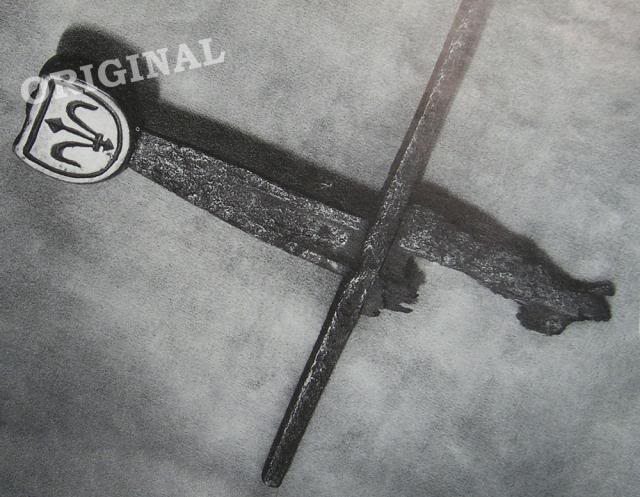| Author |
Message |
|
Mattia Perroco
|
 Posted: Sun 23 Mar, 2014 1:32 pm Post subject: Reproduction project for an early ancestor of a Schiavona Posted: Sun 23 Mar, 2014 1:32 pm Post subject: Reproduction project for an early ancestor of a Schiavona |
 |
|
Hi everybody,
I'm Mattia from Noale near Venice (Veneto) and I my new project is to reproduce an early ancestor of the Schiavona that could be used during the War of Chioggia (1378-1381).
In details i need some reference for a "S" shape crossguard and a shield shape pommel during this period. I find that this shape could be originated from Serbia and Hungary, but I'm not able to find any museum/effigy source.
Could you be so kind to help me please?
PS: sorry if my english is not good.
Have a nice day,
Mattia
|
|
  |
 |
Roger Hooper

|
 Posted: Sun 23 Mar, 2014 2:22 pm Post subject: Posted: Sun 23 Mar, 2014 2:22 pm Post subject: |
 |
|
never mind 
Last edited by Roger Hooper on Sun 23 Mar, 2014 9:56 pm; edited 1 time in total
|
|
  |
 |
Luka Borscak

|
 Posted: Sun 23 Mar, 2014 2:44 pm Post subject: Posted: Sun 23 Mar, 2014 2:44 pm Post subject: |
 |
|
|
I don't think you will find any such sword earlier than 15th century...
|
|
  |
 |
|
Mattia Perroco
|
 Posted: Sun 23 Mar, 2014 3:32 pm Post subject: Posted: Sun 23 Mar, 2014 3:32 pm Post subject: |
 |
|
quoted from "The Schiavona and its Influences" article from Nathan Robinson:
"The "cat's head" pommel, called katzenkopfknauf in German, can be found on surviving examples of cross-hilted swords of the 14th century. Many of said examples can be traced into the hands of Slavonic soldiers stationed in southern Europe and in the employ of the armies of Spain and Venice.
These swords have hilts with a square or rectangular pommel and feature a raised circular boss within its center and a horizontally recurved cross-guard, often so curved as to form circles. Guards of this same type can be traced to 14th and 15th century Hungarian swords, having similar pommels with less squared and more shield-like shapes."
I'ts been a month that I'm searcing for these swords, but I don't find anything yet.
|
|
  |
 |
Luka Borscak

|
 Posted: Sun 23 Mar, 2014 4:19 pm Post subject: Posted: Sun 23 Mar, 2014 4:19 pm Post subject: |
 |
|
| Mattia Perroco wrote: | quoted from "The Schiavona and its Influences" article from Nathan Robinson:
"The "cat's head" pommel, called katzenkopfknauf in German, can be found on surviving examples of cross-hilted swords of the 14th century. Many of said examples can be traced into the hands of Slavonic soldiers stationed in southern Europe and in the employ of the armies of Spain and Venice.
These swords have hilts with a square or rectangular pommel and feature a raised circular boss within its center and a horizontally recurved cross-guard, often so curved as to form circles. Guards of this same type can be traced to 14th and 15th century Hungarian swords, having similar pommels with less squared and more shield-like shapes."
I'ts been a month that I'm searcing for these swords, but I don't find anything yet. |
I'll try to find some from Croatia. Cat head pommels maybe, but S-curved cross in 14th century, I seriously doubt it...
|
|
  |
 |
Luka Borscak

|
 Posted: Sun 23 Mar, 2014 4:26 pm Post subject: Posted: Sun 23 Mar, 2014 4:26 pm Post subject: |
 |
|
Here is one, I found it on Viktor Berbekucz's site, he says it is from a museum in Berlin...

|
|
  |
 |
|
Mattia Perroco
|
 Posted: Fri 18 Apr, 2014 2:38 am Post subject: Posted: Fri 18 Apr, 2014 2:38 am Post subject: |
 |
|
|
Thanks for the reply! Any other info about it?
|
|
  |
 |
Luka Borscak

|
|
  |
 |
Luka Borscak

|
|
  |
 |
J.D. Crawford

|
 Posted: Fri 18 Apr, 2014 12:04 pm Post subject: Re: Reproduction project for an early ancestor of a Schiavon Posted: Fri 18 Apr, 2014 12:04 pm Post subject: Re: Reproduction project for an early ancestor of a Schiavon |
 |
|
| Mattia Perroco wrote: | Hi everybody,
I'm Mattia from Noale near Venice (Veneto) and I my new project is to reproduce an early ancestor of the Schiavona that could be used during the War of Chioggia (1378-1381).
In details i need some reference for a "S" shape crossguard and a shield shape pommel during this period. I find that this shape could be originated from Serbia and Hungary, but I'm not able to find any museum/effigy source.
Could you be so kind to help me please?
PS: sorry if my english is not good.
Have a nice day,
Mattia |
Marko Alexksic describes Schiavonesch swords in 'Medieval Swords from Southeastern Europe'. His 'O family' of swords are 1 hand or 1.5 hand, have a cat's head Z3 pommel (although more squarish than shield shaped) and S shaped cross and XIXa blades. Most are from 15th century but he says there are several that can be dated firmly (for example by Arabic inscriptions) to your desired time period. I would reccommend getting hold of this book (see sections on Z pommels and type O family, as well as some of the catalog listings and pictures at end of book).
|
|
   |
 |
|
|

